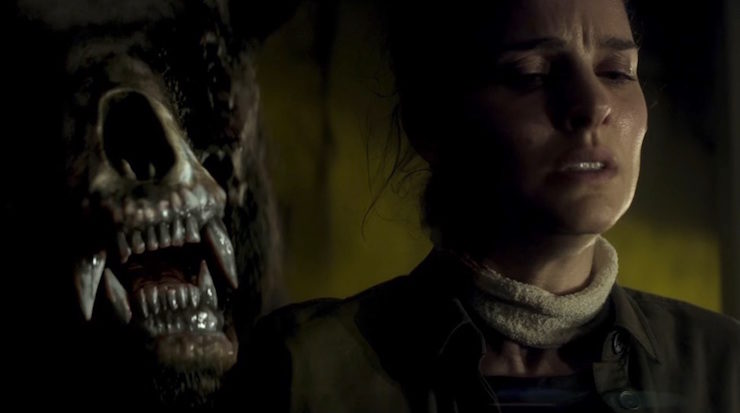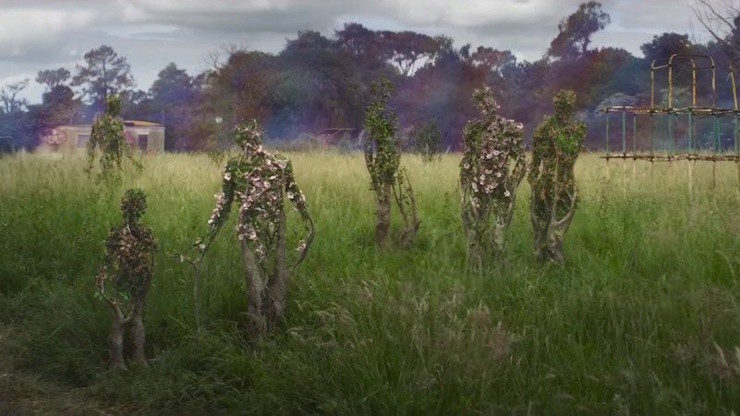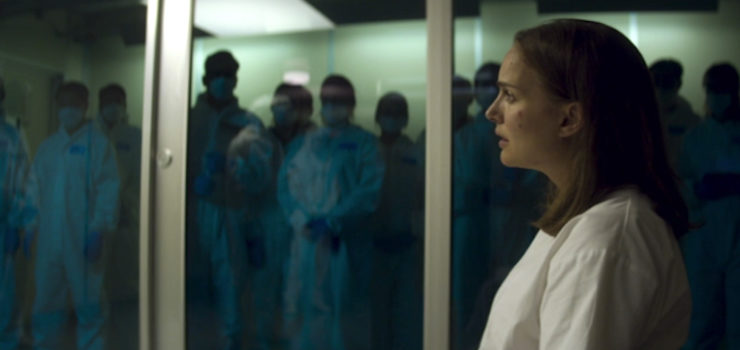28 Days Later was the first movie that had me stumbling out of the theater in a mind-fried daze. Back in 2002, I knew director Danny Boyle from Trainspotting and The Beach, both movies with some troubling themes, but I went in expecting nothing more than a fun zombie romp (this was, after all, long before zombies had infected every part of popular culture). But the movie sold the “humans are the real monsters” trope in a way I had never before seen. By the time Jim (Cillian Murphy) nearly attacks Selena (Naomi Harris) in his bloody rage, I no longer knew what to believe or expect. My friend and I were so shocked by what we’d just experienced that we drove 20 minutes in the wrong direction before realizing our error.
16 years later, I left Annihilation in a similar state. Working here as both writer and director, 28 Days Later screenwriter Alex Garland uses sci-fi tropes to raise questions about identity and existence, with a level of urgency found only classics such as Solaris, Stalker, and John Carpenter’s The Thing.
(Spoilers ahead.)
Much of the movie’s strength comes from its final scene, in which protagonist Lena (Natalie Portman) sets herself on fire. The only survivor of a scientific expedition into a contaminated area called “The Shimmer,” where a reality altering energy emits from a downed meteor, Lena reaches ground zero only to encounter an alien creature. As she and the creature struggle, it shifts shapes to adopt Lena’s form. Horrified by her double and unable to overcome it, Lena finally escapes when she incinerates her doppelgänger with a phosphorous grenade.
The double wasn’t Lena. But in the movie’s final shot, we see that Lena isn’t Lena either, not completely. As she hugs her husband Kane (Oscar Isaac) — a member of a previous exploratory squad and, until Lena, the only person to ever return from The Shimmer — the camera catches a rainbow band glimmering in her eye, indication that she’s been biologically changed. The same glow exists in Kane’s eyes, further confirming earlier suggestions that he’s not Kane, but his doppelgänger. And yet the film closes on the two of them, holding each other, a moment both warm and unsettling.
The movie’s ending complicates what has become the standard interpretation of Annihilation, one advanced by Garland himself. In an interview with The Verge, Garland states that his interest in the source novel by Jeff VanderMeer was “born out of a funny kind of preoccupation […] that everybody is self-destructive.”
Lots of self-destruction does certainly happen in Annihilation, from the cancer cells that Lena studies in her day job as a biologist at Johns Hopkins University to the characters’ decision to enter an area from which no one returns. But as demonstrated by the hugging hybrids that end the film, nothing goes to nothing in Annihilation, despite what its title suggests.
Shaping the Self
Characters self-destruct in Annihilation, but what do we mean by “self”? What do we mean by “destruct”? Turns out, those are pretty loaded questions.
Philosophers define selfhood in many ways, but for the sake of simplicity, I’m going to break it down into to camps. Following the Enlightenment teaching of thinkers such as John Locke and Jean-Jacques Rousseau, Romantics imagine the self as fully-formed and fully sufficient, endowed by God with the facility of reason. They consider some interaction with others healthy, but they worry that too much exposure to other people corrupts the self. These types of people talk about “letting me be me” or going off to “find myself.”
Conversely, Postmodernists include existentialists like Jean-Paul Sartre and contemporary thinkers like K. Anthony Appiah, who argue that the self is social, that we need other people to construct our identities. As German philosopher Martin Heidegger puts it, humans are “thrown” into a world that already exists, and we make use of ideas and materials already in place. None of us invent a hammer to build something, nor do we create new language to express ourselves — we figure out who we are by copying other people or using ideas that preceded us.
Most Americans and Europeans subscribe to the Romantic form of selfhood, so when you hear the phrase “self-destruction,” you probably think of someone making a decision to hurt themselves. And you probably think of that as a bad thing, because we assume that it is important to protect one’s self.
Some scenes in Annihilation endorse this type of thinking, such as the one in which psychiatrist Dr. Ventress (Jennifer Jason Leigh) gives Lena a late-night lecture on human impulses. “Almost none of us commit suicide,” she explains, but “almost all of us self-destruct.” She backs up her claim with mundane examples about people smoking or sabotaging their marriages, all things that seem like people making intentional decisions in the Romantic vein.
But that scene ends with an event that gestures toward the Postmodernist form of selfhood. Ventress’s speech is cut off by a disruption in the form of a giant bear tearing through their perimeter fence. As Lena and Ventress search the darkness for the predator, Garland cuts to anthropologist Cass Sheppard (Tuva Novotny), waking up and rousing the others, paramedic Anya Thorensen (Gina Rodriguez) and physicist Josie Radek (Tessa Thompson).
The bear mauls Sheppard as soon as she arrives, and Garland presents the attack as violent and chaotic, thus reinforcing the idea that Sheppard is suicidal. After all, just a few scenes earlier, Sheppard told Lena that everyone on the expeditions was grieving something (in her case, a daughter killed by leukemia). Perhaps she ran toward the attack because she wanted to die and the bear offered a way.
But that reading assumes that Sheppard knew there was a bear on the loose and that she did not want to fight it. That reading assumes that she wasn’t really trying to help her teammates. That reading ignores the Postmodern definition of the self.
Shifting in the Shimmer
The bear kills Sheppard, but she’s not completely gone. Instead, her vocal chords merge with that of the bear; so the next time the creature appears to menace the team, its growls are Sheppard’s dying cries for help. That’s one of the most disturbing cinematic moments I’ve ever seen, but it’s not an example of self-destruction in the Romantic sense because Sheppard isn’t destroyed — she’s just remade. Parts of her remain, even if the form is horrific.
The amalgamation occurs because of The Shimmer’s prismatic qualities, as the radiation refracts and remixes everything within the area: light waves, radio waves, and even DNA. Everything within The Shimmer mixes together, fusing with other life forms around it and creating the movie’s monsters, the screaming bear and a huge alligator/shark hybrid.
But that’s not all it creates. When a government agent calls The Shimmer “nightmarish,” Lena’s quick to agree, but she insists that it’s “also beautiful.” Garland and cinematographer Rob Hardy visualize The Shimmer’s effects by bathing the area in a rainbow haze, with a soft-focus blur that gives the screen almost an impressionistic effect, blurring distinctions between people, plants, and predators. The Shimmer makes lovely the otherwise hideous image of vibrant purple moss sprouting from a misshapen corpse and creates unnerving flower bushes growing in the shape of people.
This mixing effect undercuts the idea of an individual actor, so central to the Romantic vision of selfhood. Romantics believe in rational actors, fully-formed and separate individuals who make decisions based on the most reasonable good for themselves. But the Shimmer keeps people from being separate, and no one acts for their own good.
The movie constantly intermingles the gorgeous and the grotesque in a way that undermines simple distinctions. Radek dies by surrendering herself to a field of flowers, vines sprouting from the scars where she cut her own arms as she tells Lena, “Ventress wants to face it. You want to fight it. But I don’t think I want either of those things.” Thompson delivers these lines in a tone that balances resignation with resolve, as her character disappears in the valley, giving a sense of grace to her character’s dissolution into flora.
Garland presents Ventress’s death with similar ambiguity. Lena finds Ventress, driven into The Shimmer by a terminal cancer diagnosis and a sense of responsibility for recruiting members for previous expedition teams, sitting at the meteor crash site and explaining the nature of The Shimmer. “It breaks down our bodies and our minds […] into their smallest parts until not one part remains,” she explains. But after declaring “annihilation,” Ventress dissolves into light, inaugurating the film’s abstract climax, as the light changes shape and color before transforming into the being that copies Lena’s form.
More than just the ravings of a dying woman, Ventress’s final words deserve attention. She seems to be saying that The Shimmer ultimately disintegrates biological forms, and that’s one way of understanding what we see in her death — that her very existence has been diffused into light.
But that’s not what she says. The Shimmer breaks people down until not one part remains. Not singular. Not alone.
And that’s what we see when Ventress dissolves — an explosion of multicolored, freeform light, from which Garland’s camera pans to find Lena staring in a state of ecstasy, or terror, or both. The camera follows rich droplets of blood floating from Lena’s eye and into the happening, where it mixes and mingles and forms a humanoid creature that eventually takes Lena’s shape, merging with Lena to create the hybrid on which the movie closes. The Shimmer has broken her down until many parts — not just one part — remain.
Ventress, just like Lena and everyone else on the team, becomes something different. And while it might be frightening, it is undeniably lovely. As the Lena hybrid who closes the movie puts it, The Shimmer wasn’t destroying, “It was changing.” This changing mirrors the Postmodern idea of selfhood: to create an identity, one must mix together with the people around you to create some new and stunning.
Impossible Immunity
As illustrated by Ventress’s explosion into color and by Sheppard’s amalgamation with the bear, Annihilation understands self-destruction to be at once monstrous and magnificent. While that idea might seem oxymoronic, it’s central to Postmodern philosophies of selfhood. Thinkers like Emmanuel Levinas and Jacques Derrida recognize that it’s not fun to have someone else surprise you or interrupt your assumptions about how the world works, to make you responsible for them—but it’s necessary in order to have a full life. As Hannah Arendt puts it in The Human Condition, “a life spent in the privacy of ‘one’s own,’ outside the world of the common, is ‘idiotic’ by definition.”
The contemporary Italian political philosopher Roberto Esposito believes that model of selfhood has important implications for the way we make communities. Tracing the word “community” to its original Latin, Esposito finds that that the term means “shared gift, debt, or wound.” To be in community, then, is both necessary and painful. Necessary because we need others to have a full life; painful because it isn’t pleasant to be around people different from us.
Esposito argues that because communities are always painful, they should not focus on safety. In fact, he points out that if community means “shared gift, debt, or wound,” then immunity means “removed gift, debt, or wound” — literally, immunity is the opposite of community.
That’s an unusual way of thinking about community in the 21st century. We constantly think about forming groups to make us safe, whether it be a club with other like-minded members or a nation devoted to defending its citizens. In fact, a lot of America’s post-9/11 policies, from attacks on other countries to deportations to talks of border walls — are fueled by the belief that safety is paramount.
Horror movies like Annihilation could be used to endorse that idea, because certainly a lot of horrible things happen in them—like dying in the jaws of a bear that mimics your friend’s final screams. But given the film’s emphasis on Postmodern selfhood, in which one’s identity mixes with that of others, we have to reconsider what the movie means by “self destruction.”
Buy the Book


The Barrow Will Send What it May
While talking about the human need to self-destruct, Ventress tells Lena that the impulse is more biological than mental, something hardwired into people. There’s a sense there that people don’t want to protect themselves, that they want to destroy their separate and safe selves to create something new.
What is that something new? I think we get an idea of what the movie means by paying attention to the visuals in the frame narrative, in which Lena is interrogated by a government agent called Lomax (Benedict Wong).
The movie begins with Lena after she’s escaped The Shimmer and been placed in quarantine, under observation by Lomax and other agents — her explanation of what happened fills out the body of the film. Throughout these scenes, Lomax and the other government workers wear hazmat suits, and Lena is held within a containment area, presumably to keep people safe from whatever diseases she may have contracted.
Lena never breaks these seals, nor does she touch any of the other characters. But Garland and Hardy shoot the interrogations through the glass and plastic surrounding Lena, always catching in frame both the storyteller and the interlocutor. Close-up shots on Wong feature not just Lomax’s face as he hears and interprets the story, but also Lena in the reflection of his shield. Even in the real world, even surrounded by immunization equipment, characters mix together, influencing one another as they create the narrative we watch.
The story’s existence, then, is a product of mixing: Without the amalgamation of Lomax and Lena, without the participation of film and audience, there would be no Annihilation. And in the same way Lomax and Lena and Kane change in the telling of the story, so also do we change as we experience and make sense of the film. Sometimes it’s horrible, sometimes it’s beautiful, but it’s unavoidably transformative.
Joe George‘s writing has appeared at Think Christian, FilmInquiry, and is collected at joewriteswords.com. He hosts the web series Renewed Mind Movie Talk and tweets nonsense from @jageorgeii.













